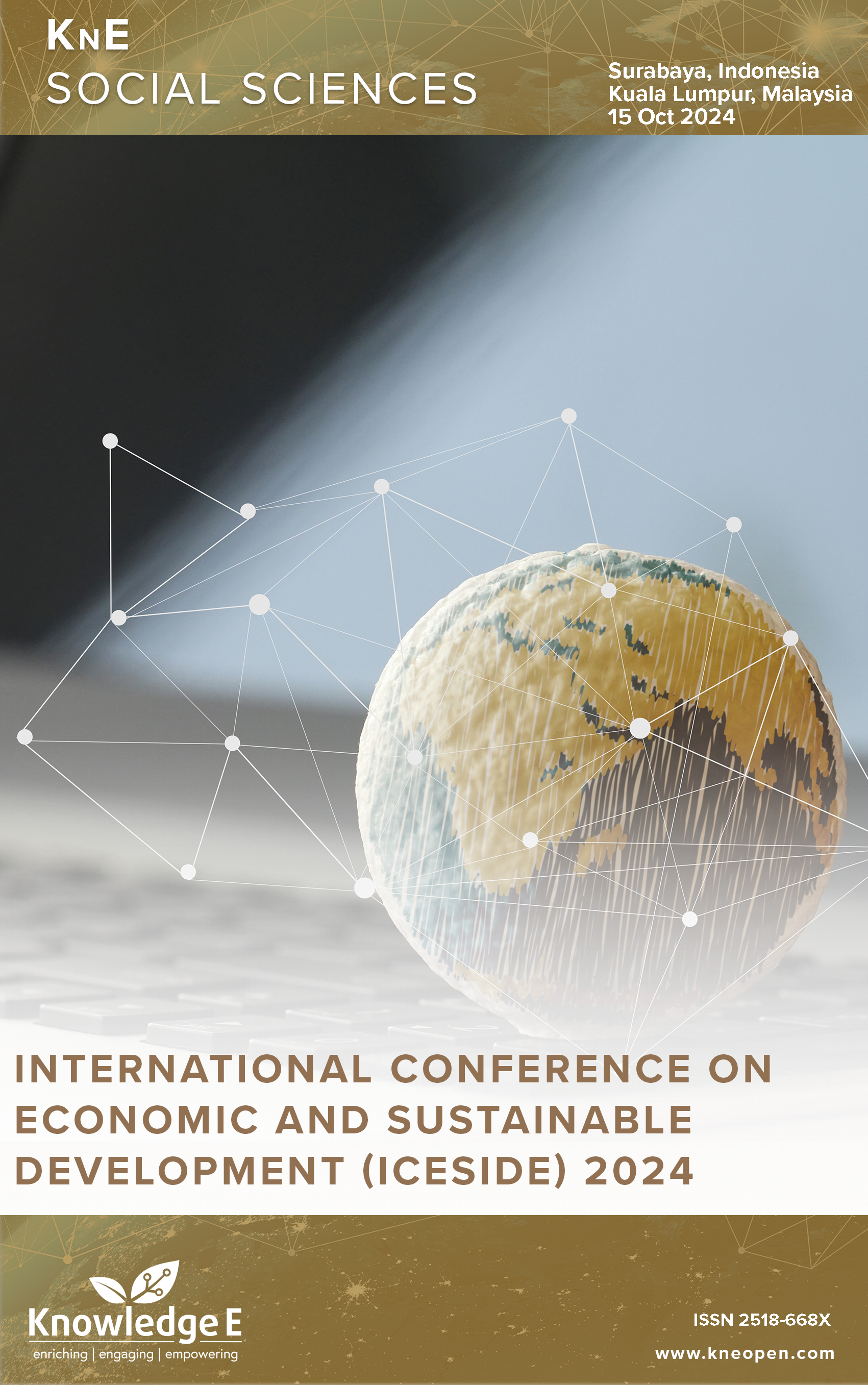Backward and Forward Linkage Effects on Firm Survival: Evidence from East Java Large and Medium Manufacturing Survey
DOI:
https://doi.org/10.18502/kss.v10i5.18119Keywords:
firm survival, backward linkages, forward linkages, survival analysis, IndonesiaAbstract
Firm survival in dynamic business environments is significantly influenced by the strength of a firm’s intersectoral linkages. While the impact of backward linkages on firm performance has been widely studied, their effect on firm survival remains unclear, especially in emerging economies like Indonesia. This study investigates the effects of both backward and forward linkages on the survival of manufacturing firms in East Java, Indonesia, using a survival analysis approach coupled with Survival-time inverse-probability-weighted regression adjustment (STIPWRA). Analysis of enterprise- level large and medium industry survey data from 1995 to 2015 (published by the Central Bureau of Statistics (BPS)), complemented by Input-Output tables for 2000, 2005, 2010, and 2015, revealed that while backward linkages did not significantly impact survival, forward linkages had a positive and significant impact. Firms with strong forward linkages demonstrated greater resilience and longer survival times. These findings highlight the crucial role of forward-looking strategies, like cultivating strong customer relationships and market positioning, for the long-term sustainability of manufacturing firms. Policy implications center on fostering robust forward linkages through strategic investments in infrastructure, R&D, and workforce training to enhance the competitiveness of East Javan manufacturing enterprises.
References
Jordaan JA, Douw W, Qiang Z. Multinational Corporation Affiliates, Backward Linkages, and Productivity Spillovers in Developing and Emerging Research Economies: Evidence and working paper [Internet]. Policy Making. 2020 [cited 2025 In: Policy Jan 4]. Available from: https://documents.worldbank.org/pt/publication/documents-reports/documentdetail/302481598274482747/multinational-corporation-affiliates-backward-linkages-and-productivity-spillovers-in-developing-and-emerging-economies-evidence-and-policy-making DOI: https://doi.org/10.1596/1813-9450-9364
Takii S, Narjoko D. FDI forward linkage effect and local input procurement : Evidence from Indonesian manufacturing. The Effects of Globalisation on Firm and Labour Performance [Internet]. 2020 Nov 30 [cited 2025 Jan 4];62–80. Available from: https://www.taylorfrancis.com/chapters/edit/10.4324/9781003050902-4/fdi-forward-linkage-effect-local-input-procurement-sadayuki-takii-dionisius-narjoko DOI: https://doi.org/10.4324/9781003050902-4
Win MMK, Kakinaka M. Firm performance and backward and forward linkages: the case of the garment sector in Myanmar. Asia-Pacific Journal of Accounting & Economics [Internet]. 2022 Mar 4 [cited 2025 Jan 4];29(2):523–46. Available from: https://www.tandfonline.com/doi/abs/10.1080/16081625.2019.1600415 DOI: https://doi.org/10.1080/16081625.2019.1600415
Ben Hassine H, Boudier F, Mathieu C. The two ways of FDI R&D spillovers: evidence from the French manufacturing industry. Appl Econ [Internet]. 2017 May 28 [cited 2025 Jan 4];49(25):2395–408. Available from: https://www.tandfonline.com/doi/abs/10.1080/00036846.2016.1240345 DOI: https://doi.org/10.1080/00036846.2016.1240345
Falk M. The Relationship Between FDI Through Backward Linkages and Technological Innovations of Local Firms: Evidence for Emerging Economies. East Europ Econ [Internet]. 2015 Sep 3 [cited 2025 Jan 4];53(5):424–38. Available from: https://www.tandfonline.com/doi/abs/10.1080/00128775.2015.1065507 DOI: https://doi.org/10.1080/00128775.2015.1065507
Böhme MH, Thiele R. Informal-formal linkages and informal enterprise per- formance in urban West Africa. European Journal of Development Research [Internet]. 2014 Aug 7 [cited 2025 Jan 4];26(4):473–89. Available from: https://link.springer.com/article/10.1057/ejdr.2014.26 DOI: https://doi.org/10.1057/ejdr.2014.26
Gorodnichenko Y, Svejnar J, Terrell K. When does FDI have positive spillovers? Evidence from 17 transition market economies. J Comp Econ. 2014 Dec 1;42(4):954– 69. DOI: https://doi.org/10.1016/j.jce.2014.08.003
Görg H, Ruane F, Görg H, Ruane F. An Analysis of Backward Linkages in the Irish Elec- tronics Sector. Econ Soc Rev (Irel) [Internet]. 2000 [cited 2025 Jan 4];31(3):215–35. Available from: https://EconPapers.repec.org/RePEc:eso:journl:v:31:y:2000:i:3:p:215-235
Anwar S, Nguyen LP. Foreign direct investment and export spillovers: Evidence from Vietnam. International Business Review. 2011 Apr 1;20(2):177–93. DOI: https://doi.org/10.1016/j.ibusrev.2010.11.002
Bitzer J, Geishecker I, Görg H. Productivity spillovers through vertical linkages: Evidence from 17 OECD countries. Econ Lett. 2008 May 1;99(2):328–31. DOI: https://doi.org/10.1016/j.econlet.2007.07.015
Görg H, Ruane F. Multinational Companies and Linkages: Panel-Data Evidence for the Irish Electronics Sector. Int J Econ Bus [Internet]. 2001 [cited 2025 Jan 4];8(1):1–18. Available from: https://www.tandfonline.com/doi/abs/10.1080/13571510151075215 DOI: https://doi.org/10.1080/13571510151075215
Görg H, Ruane F. Linkages between Multinationals and Indigenous Firms: Evidence for the Electronics Sector in Ireland. 1998;
Miller RE, Blair PD. Input-Output Analysis Foundations and Extensions Second Edition. Second Edition. CAMBRIDGE UNIVERSITY PRESS; 2009. DOI: https://doi.org/10.1017/CBO9780511626982
Cox DR. Regression Models and Life-Tables. J R Stat Soc Series B Stat Methodol [Internet]. 1972 Jan 1 [cited 2025 Jan 4];34(2):187–202. Available from: https://dx.doi.org/10.1111/j.2517-6161.1972.tb00899.x DOI: https://doi.org/10.1111/j.2517-6161.1972.tb00899.x
Cox DR. Partial likelihood. Biometrika [Internet]. 1975 Aug 1 [cited 2025 Jan 4];62(2):269–76. Available from: https://dx.doi.org/10.1093/biomet/62.2.269 DOI: https://doi.org/10.1093/biomet/62.2.269
Wooldridge JM. Inverse probability weighted estimation for general missing data problems. J Econom. 2007 Dec 1;141(2):1281–301. DOI: https://doi.org/10.1016/j.jeconom.2007.02.002
Newey WK. A method of moments interpretation of sequential estimators. Econ Lett. 1984 Jan 1;14(2–3):201–6. DOI: https://doi.org/10.1016/0165-1765(84)90083-1
Wooldridge JM. Econometric Analysis of Cross Section and Panel Data, Second Edition. 2010;
Drukker DM. Using gmm to solve two-step estimation problems [Internet]. 2014 [cited 2025 Jan 4]. Available from: https://blog.stata.com/2014/12/08/using-gmm-to-solve-two-step-estimation-problems/
Korwatanasakul U, Paweenawat S. Trade, Global Value Chains, and Small and Medium-Sized Enterprises in Thailand: A Firm-Level Panel Analysis. 2020 May 11 [cited 2025 Jan 4];(1130). Available from: https://www.adb.org/publications/trade-global-value-chains-and-sme-thailand-firm-level-panel-analysis
Domowitz I, Hubbard RG, Petersen BC. Business Cycles and the Relationship between Concentration and Price-Cost Margins. Rand J Econ. 1986 Spring;17(1):1. DOI: https://doi.org/10.2307/2555624
Rodríguez-Clare A. Multinationals, Linkages, and Economic Development. Am Econ Rev [Internet]. 1996 [cited 2025 Jan 4];86(4):852–73. Available from: https://www.jstor.org/stable/2118308

